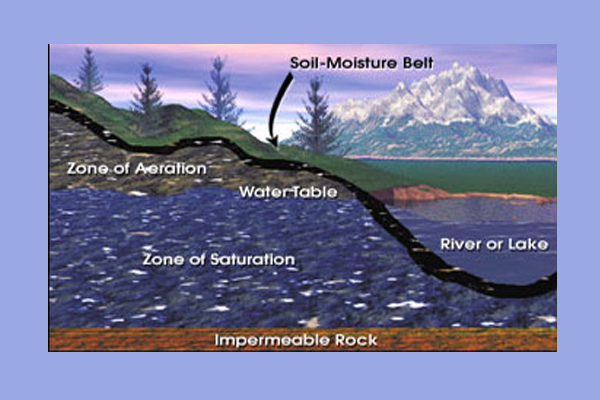The Water Table
When precipitation falls over the land surface, it follows various routes. Some of it evaporates, returning to the atmosphere, and some seeps into the ground (as soil moisture or groundwater). Groundwater is found in two layers of the soil, the "zone of aeration," where gaps in the soil are filled with both air and water, and, further down, the "zone of saturation," where the gaps are completely filled with water. The boundary between the two zones is known as the water table, which rises or falls as the amount of groundwater increases or decreases. The rest of the water runs off into rivers and streams, and almost all of this water eventually flows into the oceans or other bodies of water, where the cycle begins anew (or, more accurately, continues). At different stages of the cycle, some of the water is intercepted by humans or other life forms.
The water table is the top of the zone of saturation and intersects the land surface at lakes and streams. Above the water table lies the zone of aeration and soil moisture belt, which supplies much of the water needed by plants.
Even though the amount of water in the atmosphere is only 12,900 cubic kilometers (a minute fraction of Earth's total water supply that, if completely rained out, would cover the Earth's surface to a depth of only 2.5 centimeters), some 495,000 cubic kilometers of water are cycled through the atmosphere every year, enough to uniformly cover the Earth's surface to a depth of 97 centimeters. Because water continually evaporates, condenses, and precipitates, with evaporation on a global basis approximately equaling global precipitation, the total amount of water vapor in the atmosphere remains approximately the same over time. However, over the continents, precipitation routinely exceeds evaporation, and conversely, over the oceans, evaporation exceeds precipitation. In the case of the oceans, the routine excess of evaporation over precipitation would eventually leave the oceans empty if they were not being replenished by additional means. Not only are they being replenished, largely through runoff from the land areas, but, over the past 100 years, they have been over-replenished, with sea level around the globe rising by a small amount. Sea level rises both because of warming of the oceans, causing water expansion and thereby a volume increase, and because of a greater mass of water entering the ocean than the amount leaving it through evaporation or other means. A primary cause for increased mass of water entering the ocean is the calving or melting of land ice (ice sheets and glaciers).
Throughout the hydrologic cycle, there are an endless number of paths that a water molecule might follow. Water at the bottom of Lake Superior may eventually fall as rain in Massachusetts. Runoff from the Massachusetts rain may drain into the Atlantic Ocean and circulate northeastward toward Iceland, destined to become part of a floe of sea ice, or, after evaporation to the atmosphere and precipitation as snow, part of a glacier. Water molecules can take an immense variety of routes and branching trails that lead them again and again through the three phases of ice, liquid water, and water vapor. For instance, the water molecules that once fell 100 years ago as rain on your great grandparents' farmhouse in Iowa might now be falling as snow on your driveway in California.
Related Links:
 The Hydrologic Cycle - A Multi-Phased Journey
The Hydrologic Cycle - A Multi-Phased Journey
Browse Quotes and Proverbs...
Cool Quotes Vol. 1
If silence is golden, then speech is platinum...
Cool Quotes Vol. 2
If you are too careful, you are so occupied in being...
Cool Quotes Vol. 3
The only time to eat DIET FOOD is while you're waiting...
Wise Old Sayings
One today is worth two tomorrows...

Education
Many people benefit from knowledge and interesting facts...Did You Know?
Of the various components that are found in the human body, water occurs in the largest quantity. As a food substance, it is an extremely important feature of a person's diet. Its chief purpose is to replenish the liquids of the body and to assist in the digestion of food.
Although nature provides considerable amounts of water in most foods, large quantities must be taken in the diet as a beverage. In fact, it is the need of the body for water that has led to the development of numerous beverages. Besides being necessary in building up the body and keeping it in a healthy condition, water has a special function to perform in food preparation and cooking.
Ranking next to water in the quantity contained in the human body is mineral matter. This constituent, which is also called ash or mineral salts, forms the main part of the body's framework, or skeleton.
In the building and maintaining of the body, mineral salts serve three purposes--to give rigidity and permanence to the skeleton, to form an essential element of active tissue, and to provide the required alkalinity or acidity for the digestive juices and other secretions.
Plants in their growth seize from the earth the salts of minerals and combine them with other substances that make up their living tissue. Then human beings, as well as other living creatures, get their supply of these needed salts from the plants that they take as food, this being the only form in which the salts can be thoroughly assimilated.






